The birth of a child is a long-awaited and exciting event. But when the birth is over, the mother has other worries and responsibilities.
You have to learn to care for the baby, anticipate his desires and recognize needs.
Often in the first month of life, a rash pops up on the face or body of a child, the causes of which are unknown to young parents.
People who are allergic to penicillin may receive other antibiotics, such as doxycycline. People who cannot take doxycycline may receive azithromycin. However, in some parts of the world, syphilis is becoming increasingly resistant to azithromycin.
Because people with primary and secondary syphilis can pass the infection to others, they should avoid sexual contact until they or their sexual partners have finished treatment. If people have primary syphilis, all sexual partners in the past three months are at risk of contracting the infection. If they have secondary stage syphilis, all sexual partners of the past year are at risk. These sexual partners should have a blood test to check for antibodies to the bacteria.
- All information on the site is for informational purposes and is NOT a guide to action!
- Give you an ACCURATE DIAGNOSIS only DOCTOR!
- We kindly ask you DO NOT self-medicate, but book an appointment with a specialist!
- Health to you and your loved ones!
Acne in a newborn can terrify an inexperienced mother, because in her head the thought immediately arises that not everything is in order with the health of the child.
If the result is positive, sexual partners need treatment. Some doctors simply treat all sexual partners without waiting for test results. Many people with early stage syphilis, especially those with secondary syphilis, develop a reaction between six and twelve hours after the first treatment. This reaction, called the Jarisch-Herxheimer reaction, causes fever, headache, sweating, shivering chills, and temporary worsening of syphilis ulcers. Doctors sometimes confuse this reaction with an allergic reaction to penicillin.
But do not prematurely panic and worry.
After all, most infantile rashes are completely harmless, as they are an indicator of the imperfection of the sebaceous and sweat glands or non-compliance with the rules for caring for delicate integuments.
However, there are other factors that provoke the appearance of pimples in children in 1 month of life, which it is better for mom and dad to find out in advance.
Rarely, people with neurosyphilis have seizures or a stroke. The symptoms of this reaction usually subside within 24 hours and rarely cause permanent damage. After treatment, blood tests and tests are done periodically until an infection is found. If treatment for primary, secondary, or latent syphilis is successful, most people will not show any more symptoms. But treatment for the tertiary stage of syphilis cannot reverse damage to organs such as the brain or heart. People with this kind of damage usually don't get better after treatment.
Causes
First of all, you should pay attention to the conditions in which the child is kept.
Is he hot, is he overeating, is there enough fluid in his body. After all, the skin is a reflection of the coordinated work of all systems.
Hormonal
It could be:
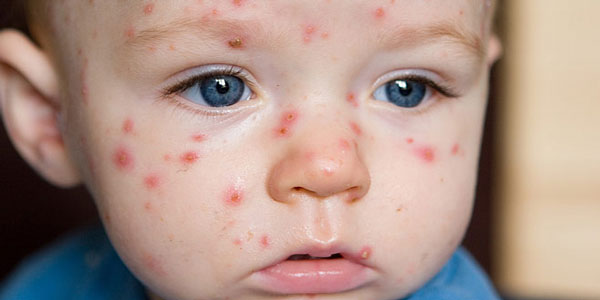
People who have been cured of syphilis do not become immune to the disease and can become infected again. When one thinks of acne or a widespread spine, teenagers are soon remembered, which are usually preferred targets, but babies can also be victims of those boring "balls" on their small faces.
Acne is the result of hormonal changes and can reach many babies when they are in their third or fourth week of life, and they can last to term. But why are small, children already suffering from acne? This is what you will see in the following paragraphs.
- - watery blisters that burst and turn into sores;
- measles - a rash with signs of a cold;
- rubella - spots behind the ears, gradually spreading to the face and whole body;
- scarlet fever - rashes, on the back, under the arms, accompanied by sore throat, vomiting.
In the mouth of the baby, you can see a white coating covering the tongue, lips and the inner surface of the cheeks.
Its onset is due to the release of hormones produced by the mother's body during pregnancy, but it may occur or increase its incidence through breastfeeding, since the baby is likely to ingest these same hormones through suckling breast milk.
Neonatal acne: Acne on a child that mixes with the kidneys. Neonatal acne is different from a rash because the latter is associated with an allergic process. Corners appear on the skin in the same way as they appear in young people and adults as small blackheads, small thorns, or pimples with pus. Even though it is considered a natural body predisposition and does not pose a major problem, it is always a good idea to consult with your pediatrician so that you can better assess your child's skin condition.
This is candidal stomatitis or thrush caused by a fungus. Often, at the same time, it is found in the mother's nipples. If you carefully remove the plaque with a bandage, then pink foci of inflammation are visible under it.
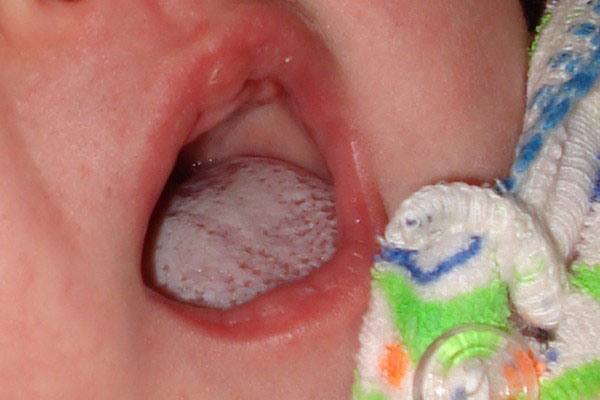
Causes of a rash on the face in infants
Although it has many physical similarities to common adult acne, the correct treatment for infants is completely different. There are some specific cases where this needs to be done as long as hormone replacement or even the use of certain products that make the skin less thickened.
What is neonatal acne?
Cleansing is necessary with warm water, and you should not pop or squeeze pimples so that they do not cause damage or even inflammation, which is very common since the skin of children is much more sensitive than that of adults. Since this is a predisposition, considered by the doctors themselves as a natural or responsive body, it is recommended that the mother take care of the following.
The causes of the infection are insufficient compliance with the hygiene of the baby's oral cavity, dryness of the mucous membranes. The remains of sweet milk create excellent conditions for the growth of fungal flora.
Therefore, after feeding, rinse the child's mouth with water, giving him a drink.
Video: "Prickly heat - a disease of newborns"
Clean your child's face daily and only once a day with warm water and very mild soap, even if the acne is small and few prefer neutral products. Don't use products other than those meant for little ones. Formulas for children's products are much less aggressive than those for juveniles and adults.
Do not rub your hands over your child's face, be as gentle as possible, even if you use a cloth or sponge, so as not to irritate or even worsen the skin. When it's time to dry the skin, palpate lightly until you feel it is completely dry.
Varieties of acne in the chest
There are so many varieties of rashes that only an experienced doctor is sometimes able to understand their nature.
White
White pimples pop up more often on the face, on the cheeks and in the head.
- Usually they appear already in the first days after birth, but can occur after 2-3 weeks. These are harmless rashes located in localized groups.
- In appearance, pimples resemble white or yellowish beads on the surface of the integument. Their base is reddish, and pus accumulates at the top. They do not hurt, do not inflame and do not harm health.
There are two reasons for their formation.
Do not squeeze or use oily lotions, which can only damage the baby's skin. Just to strengthen, do not touch the pimples, so that they will disappear soon, and your baby's face is clean and soft as silk. Oh, before you leave, don't forget to use this article, okay?
Some people asked me about this disease, and my mother sent me a notice she got from school, reporting the Scarlet Fever disease. Today it is a simple disease, easily diagnosed and treated, with an excellent prognosis. In general, the infection is in the throat, producing tonsillitis.
- During childbirth, the mother's body releases a large amount of hormones into the blood, in particular, adrenaline. It helps the baby to pass through the narrow birth canal without harm to health. The head of the child is flattened, and he, thanks to the stress hormones that have got from the maternal bloodstream, does not feel pain and tension. But from their excess, white pimples appear on the covers.
- From insufficient maturity of the sebaceous glands, a rash occurs on the forehead, on the nose, and. As soon as the baby grows up, the rashes disappear without a trace.
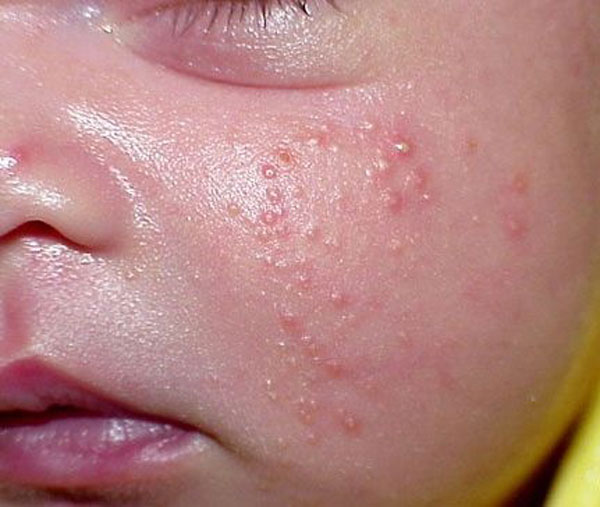
It could be
Between the ages of 3 and 7, the largest number of cases was observed, which rarely occurred below 3 years and above. In general, the first "spots" appear on the neck, torso, armpits and groin, but spread throughout the body. The most important feature of this rash is the texture of the skin, which looks like fine sandpaper. In some cases, children will have pallor around the mouth and the tongue may have a whitish layer in the first few days, but this changes and then looks like a strawberry. This eruption takes 7 to 10 days to disappear, but can take up to 3 weeks to disappear.
White dots on the face of a newborn, the size of a pinhead, are milia.
- Excess sebaceous secretion that clogged the excretory ducts of the glands.
- They can not be picked out, treated with alcohol or squeezed out.
After a few weeks or months, they disappear on their own.
Red
The red color of the rash is a sign of inflammation.
Some children have hair exfoliation as the red patches disappear. Often this manifestation on the skin is accompanied by tonsillitis. This test is performed almost on time and, when positive, eliminates the need for a culture. When it is negative, one must wait for the culture result. However, a small percentage of children who do not receive adequate treatment may develop two other serious illnesses: rheumatic fever and acute diffuse glomerulonephritis. The former reaches several systems or organs and produces carditis.
Allergic causes of rashes
The second reaches the kidneys with a picture of edema and high blood pressure. With proper treatment, Scarlet fever does not run the risk of becoming one of these diseases. Therefore the importance of ten days of antibiotic is prescribed at the right times. There is no need to indicate the re-introduction of the tube in the throat. Has eruptions of small bright or red buttons, especially on the forehead or head, neck, chest, or area. See your doctor if your child.
- Allergies can be the cause of small local pimples.
- And spotty rashes or bubbles with unclear contents - viral disease skin.
Large
Large purulent acne can be a symptom of a bacterial infection (activation, streptococcus and other pathogenic microbes).
Self-medication in this case is strictly prohibited and is fraught with negative consequences and serious complications.
What are heat buttons?
Has pus that oozes from his pimples, has a swollen neck, armpit, or groin. . This is usually a skin problem. This is caused by high ambient temperature and humidity, as well as the fact that the child is too cloudy. Its clogged, causing an eruption. Pimples are not contagious except in the rare case of a bacterial infection.
Heat acne usually disappears without treatment as soon as the child stops heating up. To help your child immediately, you can safely soak your skin with fresh water or apply cold compresses to your pimples. If the rash is causing a lot of itching, apply some lotion on the scales to his pimples.
Prickly heat
Prickly heat occurs due to overheating of the child or insufficient body hygiene, especially in summer.
A rash in the form of bubbles appears in the groin, in the natural folds of the skin, on the neck and is accompanied by redness or peeling. Synthetic clothing does not allow children's skin to carry out air exchange. The child sweats, and sweat does not evaporate from the surface of the integument, leading to irritation.
Avoid overfilling him when he is sleeping or overheating the room where he is. Dress your child in light clothing so they don't sweat. . The only way to prevent heat acne is to make sure your child is not too hot.
What is scarlet fever in children?
With the advent of winter, small scarlatina school epidemics broke out. They mainly affect children from 3 years of age. Keys to better understand this disease. Scarlet fever is a benign bacterial infection. It is quite rare in infants and affects children between 4 and 10 years of age. This is a variant of sore throat caused by various streptococci, a bacterium that disperses toxins in the body and causes a red rash all over the body.
If left untreated, pimples, then small pimples will turn into pustules.

Fighting methods
You need to deal with rashes correctly:
- hormonal acne or milia they will pass on their own, so they do not need to be treated with anything;
- if you suspect an allergy it is necessary to remember what mother and child ate during the last 24 hours, how things were washed, whether new cleaning products or cosmetics, perfumes were used. Any products the mother should introduce into her diet gradually, carefully observing the reaction of the child. If you cannot determine the cause, you should consult a doctor. He will prescribe children's drugs that will save the child from itching and burning;
- candidiasis it will pass if, after each feeding, the white plaque is carefully removed with a bandage dipped in a weak soda solution. In addition, it is necessary to rinse the child's mouth clean water from leftover milk. This can be done with a syringe without a needle, pouring liquid over the cheek in small portions. Mom should wash her breasts and hands with soap before feeding. If the thrush does not go away for a long time, you can ask your doctor to prescribe a safe antifungal drug. For example, the Candide solution, which is used to lubricate the mouth and gums of the child, the mother's nipples with a cotton swab;
- with sweating the child can be bathed in water with the addition of a decoction of the string. After that, a thin layer should be applied to irritated places. It is important not to use diapers during the treatment period. Ideally, the baby should take air baths for most of the day, being without clothes;
- if the rash is caused by an infection, then the doctor should deal with the treatment. The exception is roseola, which does not need therapy. High fever can be brought down with children's paracetamol or ibuprofen;
- with dysbacteriosis It is important to establish a regular chair in a child. To do this, a nursing mother needs to eat dried fruits (prunes, dried apricots, raisins), drink sour milk. If the baby is artificial feeding, you may need to change the mixture by choosing a food from another manufacturer together with the pediatrician.
It is useful for a child who has reached the age of one month to drink raisin water.
What is contraindicated in the appearance of a rash in the baby
The child can no longer swallow anything. After 24 or 48 hours, the first small red buttons appear in the tablecloth, first on the chest, armpits, upper thighs, crooks of the elbows, on the knees, behind the ears, then the eruption conquers the entire back and stomach. The child will also have acne on the face, except for the mouth, this is the "scarlet fever mask".
Bacterial causes of a rash in a newborn
If you press your skin with your hand, it will turn white. On the 6th day, the eruption begins to disappear, giving way to the last phase of the disease: desquamation. In areas of the body where the eruption first appeared, acne is replaced by small scales that gradually take off.
To do this, a tablespoon of pure raw materials is steamed in a glass of boiling water and allowed to brew (preferably in a thermos).
What Not to Do
- It is strictly forbidden to use acne products intended for adults. Alcohol, salicylic acid, antibiotics, hormonal ointments, and other harsh substances can cause severe skin burns, irritation, or systemic side effects.
- It is forbidden to squeeze out any rashes in children. This is the most common cause infection in wounds and inflammation. Such manipulations lead to the formation of scars and scars that remain for life.
If there is acne on the skin of a newborn, then you should follow the recommendations for care:
Scarlet fever, a highly contagious disease
After a week, with good treatment, acne and fever disappear. The disease ends when large patches of skin detach from the palms of the hands and the soles of the feet. Scarlet fever is an infectious disease. Contamination is carried out by air or by contact with contaminated objects such as goblets or toys. This scarlet fever infection causes an epidemic frequently, especially in autumn and winter in schools.
Your child can pass on this streptococcus two to five days before the first signs of illness appear, and again within two or three weeks if it is not treated. This duration of infection is reduced to 48 hours if you are taking medication prescribed by your doctor.
- you need to bathe the child daily (in the heat it is possible more often) in water with the addition of a decoction of the series and. It is advisable not to use potassium permanganate, it greatly dries out the delicate integuments;
- soap and shampoo residues should be thoroughly washed off with water;
- do not wipe the skin with a towel, but get wet;
- throughout the day, it is necessary to wipe the baby's face with a sterile cotton swab dipped in boiled water;
- after defecation, the child's ass is washed with soap. It is also important to ensure that the diaper does not overflow and does not rub the skin. When changing a diaper, you need to clean the groin area with a damp baby wipe;
- after bathing, the baby should wear fresh clothes;
- you can wash things only with special baby powder or soap;
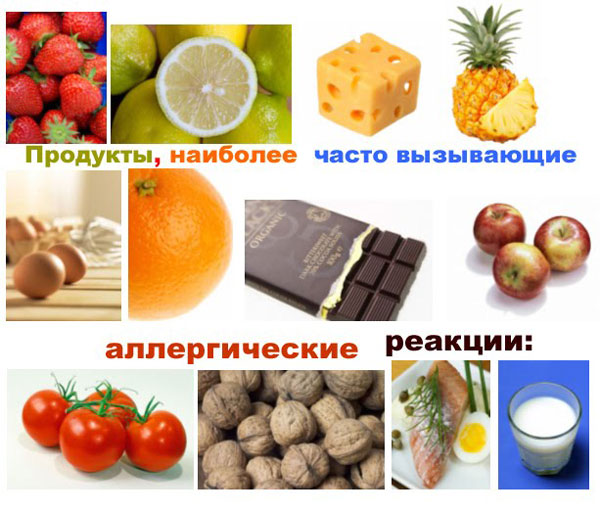
There is no urgency, but it is better to consult, at least in order to exclude another, more serious disease. The doctor or pediatrician will examine your child, feel around the neck for the presence of ganglia, and especially look at the throat and tongue for characteristic pimples. To confirm his diagnosis and the presence of streptococcus, he will take some cells from the bottom of his throat with a swab before dipping them into the reactive fluid. Rest assured, this quick test, streptotest, is absolutely painless.
At least two days at home
And in less than five minutes, the doctor will know whether the condition is bacterial or just viral. Thus, he will be able to exclude the hypothesis of another disease that gives acne and fever. For at least two days, it is preferable that your child does not go to school or a recreation center because he has a fever. He is also often very tired, and doctors advise when it is possible to leave him for two or three days at home.
Photo: foods that a nursing mother should exclude from the menu
- breastfeeding mothers must watch their diet. Exclude fried, smoked, salty, flour, citrus fruits, as well as red fruits and vegetables;
- to dry pimples, the doctor may advise lubricating them with Bepanthen or baby cream with zinc ointment.
Prevention
The well-known pediatrician E. O. Komarovsky in his book “The Health of the Child and the Common Sense of His Relatives” tells in detail how to properly care for the newborn and infant.
- The room where the child sleeps and stays most of the time should be cool and fairly humid. Optimum temperature air - from 18 to 21 degrees, and humidity - 65-75%.
- Overheating, combined with a lack of fluid intake in the baby's body, can lead to dehydration. This condition is very dangerous for health. Therefore, a child, even on breastfeeding, it is necessary to offer to drink purified water with a neutral composition, especially in the heat.
- Diapers are designed for the convenience of the mother, the baby can do without them. In summer, to avoid sweating, you should try to use them as little as possible. Ideally, if the child spends the whole day naked.
- You can bathe a newborn in a large bath after healing umbilical wound using special baby foams or shampoos. But don't soap your baby's skin every day. This can dry out the integument, lead to irritation and peeling. Simply bathing in water is enough, to which you can add a decoction of the string, if there are rashes.
- Exists universal rule treatment of non-infectious rash in newborns. Moisturize dry pimples with baby cream or oil, and dry pimples with powder.
- In the child's room, you need to carry out daily wet cleaning, ventilate the room. To clean surfaces, it is better not to use the usual household chemicals, so as not to provoke an allergic reaction. Enough warm water in which you can dilute baby soap.
The body of a newborn child does not immediately adapt to the external environment.
His skin is still too delicate and unaccustomed to irritating factors. Therefore, from time to time, various kinds of rashes appear on it.
Don't worry too much about this.
The immune system of the baby is rapidly improving, the work of the sebaceous and sweat glands is normalized.
Within a few months, his skin is less exposed to negative reactions, gradually cleared.
But if the causes of the rash cannot be found out, or acne is accompanied by other symptoms, then you should not delay contacting a pediatric specialist.
Video: "About acne on the cheeks of a one-year-old child"
Parents often think that their baby's skin will be as smooth and velvety as in pictures. However, in reality, one has to deal with various rashes and other irregularities on the skin, which are often considered commonplace in infants. However, you need to be on the alert and be able to distinguish when rashes are a sign of one of the childhood diseases, and when - a common physiological manifestation. If there is any doubt, it is better to show the child to the doctor. The reasons can be a variety of factors.
Prevention of rashes on the face in newborns, oddly enough, should begin during pregnancy - this factor directly depends on proper nutrition mothers
By determining the factors that caused abundant rashes on the face of the child, parents will be able to soberly assess what is happening and understand whether they are to blame for this situation or not. This will help correct the situation: calm down that everything is in order with the baby, or consult a doctor in a timely manner and treat the newborn. The most common causes of various rashes on the face are:
- genetic disorders;
- infectious diseases;
- malnutrition of the mother either during pregnancy or already during breastfeeding;
- allergic reactions.
- changes in the hormonal background in a newborn;
- malfunctions of the stomach;
- changes in ambient temperature.
The causes of a rash on the face of a small child can be very different. Therefore, parents should not panic at the sight of small red dots on the cheeks of their crumbs. They must understand that the skin of the baby is a very delicate and sensitive organ that instantly reacts to any changes in food and in environment. Moreover, the rash can look different: it can be blisters, spots, papules, blisters, blackheads, specks, pimples, pustules, etc. The appearance of the rash has importance for a doctor to make a correct diagnosis, so you need to know what types of rashes are.
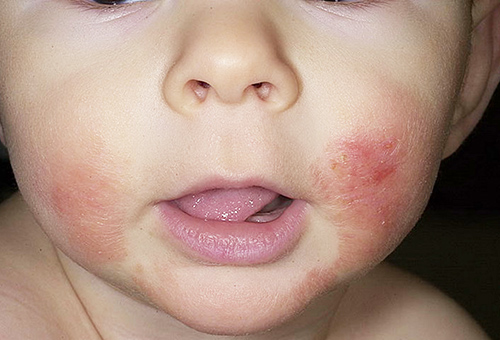
Diathesis is one of the most common types of rashes on the skin of newborns.
To understand the nature of the rashes on the face of your newborn, you need to carefully look at them. appearance and try to analyze what could have provoked their appearance. This will help to cope with the misfortune on your own or seek help from a doctor, which sometimes needs to be done as quickly as possible in order to avoid complications. Most often, the following types of rash may appear on the face of a child.
Most often, a newborn is diagnosed with cephalic neonatal pustulosis - acne. The disease manifests itself in a child aged 2-3 weeks in the form of small reddish or pink pustules on the cheeks. The reason is the hormonal restructuring of a small organism. Newborn acne is a harmless physiological rash that disappears without the use of drugs and medical assistance when the baby is 2-3 months old.
- Diathesis
Pinkish rashes on the cheeks of a child often indicate diathesis. It can be caused by disturbances in the work of the stomach, malfunctions in the not yet formed nervous system, allergic reactions to an irritant. Outwardly, the rash is a small red speck that covers not only the entire face of the child, but also the body. With improper or untimely treatment, the rash can turn into weeping sores. Often, the skin of the crumbs reacts to synthetic and woolen fabrics, low-quality washing powder, children's cosmetics (powders and creams). For an accurate diagnosis, you need to contact only a pediatrician. Treatment is reduced to the detection of an allergic factor, then to its active elimination.
- Sebaceous cysts
In 50% of newborns, doctors diagnose sebaceous cysts on the face, which are strewn with the cheeks, chin and forehead of the baby. The reason is the malfunction of the sebaceous skin glands. Outwardly, these are papules (nodular rashes) of yellow or white color. They can appear on the limbs of the crumbs and upper body. The disease does not require treatment and goes away by the end of the first month of the baby's life.
- Ritter's disease
Sometimes the baby has cloudy bubbles around the mouth, which begin to quickly spread to other parts of the body. After that, the bubbles begin to open, and the skin in this place exfoliates in the form of strips. This is Ritter's disease, which is infectious or allergic in nature. The rash is treated exclusively under the supervision of a doctor.
- Seborrheic dermatitis
Sometimes greasy flaking scales form on the baby's ears. yellow color. The causes of seborrheic dermatitis in newborns, experts call hormonal fluctuations, the development of yeast on the baby's skin. The disease resolves on its own in 2-3 weeks.
It is very important for parents in the first hours of the appearance of a rash on the face of a baby to determine at least approximately the type of rash and suggest its possible causes. This will help you make the right decision about how to help your baby: use home treatments or see a doctor. In any case, in the first hours of the rash, you need to somehow alleviate the condition of the newborn, since the rash is accompanied by discomfort and a burning sensation, from which the child will act up, cry, not sleep, and may refuse to eat.
What can parents do in such a situation?
